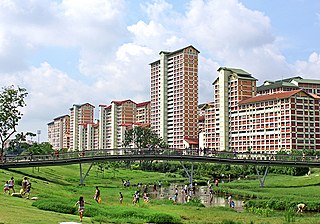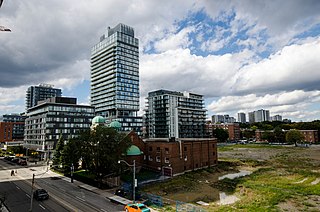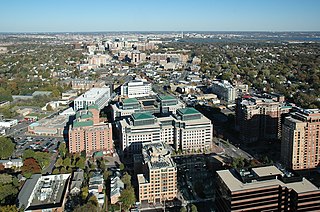
Gentrification is the process of changing the character of a neighborhood through the influx of more affluent residents and businesses. It is a common and controversial topic in urban politics and planning. Gentrification often increases the economic value of a neighborhood, but the resulting demographic displacement may itself become a major social issue. Gentrification often sees a shift in a neighborhood's racial or ethnic composition and average household income as housing and businesses become more expensive and resources that had not been previously accessible are extended and improved.

Public housing is a form of housing tenure in which the property is usually owned by a government authority, either central or local. Although the common goal of public housing is to provide affordable housing, the details, terminology, definitions of poverty, and other criteria for allocation vary within different contexts.

Regent Park is a neighbourhood located in downtown Toronto, Ontario built in the late 1940s as a public housing project managed by Toronto Community Housing. It sits on what used to be a significant part of the Cabbagetown neighbourhood and is bounded by Gerrard Street East to the north, River Street to the east, Shuter Street to the south and Parliament Street to the west. Regent Park's residential dwellings, prior to the ongoing redevelopment, were entirely social housing and covered all of the 69 acres (280,000 m²) which comprise the community. The original neighbourhood was razed in the process of creating Regent Park. The nickname Cabbagetown is now applied to the remaining historical, area north and west of the housing project, which has experienced considerable gentrification since the 1960s and 1970s.
Inclusionary zoning (IZ), also known as inclusionary housing, refers to municipal and county planning ordinances that require a given share of new construction to be affordable by people with low to moderate incomes. The term inclusionary zoning indicates that these ordinances seek to counter exclusionary zoning practices, which aim to exclude low-cost housing from a municipality through the zoning code. There are variations among different inclusionary zoning programs. Firstly, they can be mandatory or voluntary. Though voluntary programs exist, the great majority has been built as a result of local mandatory programmes requiring developers to include the affordable units in their developments. There are also variations among the set-aside requirements, affordability levels coupled with the period of control. In order to encourage engagements in these zoning programs, developers are awarded with incentives for engaging in these programs, such as density bonus, expedited approval and fee waivers.

In urban planning, transit-oriented development (TOD) is a type of urban development that maximizes the amount of residential, business and leisure space within walking distance of public transport. It promotes a symbiotic relationship between dense, compact urban form and public transport use. In doing so, TOD aims to increase public transport ridership by reducing the use of private cars and by promoting sustainable urban growth.

Real estate economics is the application of economic techniques to real estate markets. It tries to describe, explain, and predict patterns of prices, supply, and demand. The closely related field of housing economics is narrower in scope, concentrating on residential real estate markets, while the research on real estate trends focuses on the business and structural changes affecting the industry. Both draw on partial equilibrium analysis, urban economics, spatial economics, basic and extensive research, surveys, and finance.

The Million Programme was an ambitious public housing program implemented in Sweden between 1965 and 1974 by the governing Swedish Social Democratic Party to ensure the availability of affordable, high quality housing to all Swedish citizens. The program sought to construct one million new housing dwellings over a ten-year period, which it accomplished. As part of its intention to modernize Swedish housing, it also demolished many older buildings that national and local governments considered obsolescent, unhealthy or derelict.

State housing is a system of public housing in New Zealand, offering low-cost rental housing to residents on low to moderate incomes. Some 69,000 state houses are managed by Kāinga Ora – Homes and Communities, most of which are owned by the Crown. In excess of 31,000 former state houses exist, which are now privately owned after large-scale sell-offs during recent decades. Since 2014, state housing has been part of a wider social housing system, which also includes privately owned low-cost housing.

Affordable housing is housing which is deemed affordable to those with a household income at or below the median as rated by the national government or a local government by a recognized housing affordability index. Most of the literature on affordable housing refers to mortgages and a number of forms that exist along a continuum – from emergency homeless shelters, to transitional housing, to non-market rental, to formal and informal rental, indigenous housing, and ending with affordable home ownership.

Medium-density housing is a term used within urban planning and academic literature to refer to a category of residential development that falls between detached suburban housing and large multi-story buildings. There is no singular definition of medium-density housing as its precise definition tends to vary between jurisdiction. Scholars however, have found that medium density housing ranges from about 25 to 80 dwellings per hectare, although most commonly sits around 30 and 40 dwellings/hectare. Typical examples of medium-density housing include duplexes, triplexes, townhouses, row homes, detached homes with garden suites, and walk-up apartment buildings.

Water supply and sanitation in Jamaica is characterized by high levels of access to an improved water source, while access to adequate sanitation stands at only 80%. This situation affects especially the poor, including the urban poor many of which live in the country's over 595 unplanned squatter settlements in unhealthy and unsanitary environments with a high risk of waterborne disease. Despite a number of policy papers that were mainly focused on water supply and despite various projects funded by external donors, increases in access have remained limited.

The Ministry of Housing, Spatial Planning and the Environment was a Dutch ministry. It was responsible for policies on public housing, spatial planning, the environment and the housing of national government agencies. It was merged with the Ministry of Transport, Public Works and Water Management into the new Ministry of Infrastructure and the Environment on 14 October 2010.

In the United States, subsidized housing is administered by federal, state and local agencies to provide subsidized rental assistance for low-income households. Public housing is priced much below the market rate, allowing people to live in more convenient locations rather than move away from the city in search of lower rents. In most federally-funded rental assistance programs, the tenants' monthly rent is set at 30% of their household income. Now increasingly provided in a variety of settings and formats, originally public housing in the U.S. consisted primarily of one or more concentrated blocks of low-rise and/or high-rise apartment buildings. These complexes are operated by state and local housing authorities which are authorized and funded by the United States Department of Housing and Urban Development (HUD). In 2020, there were 1 million public housing units.
Green affordable housing is reasonably priced housing that incorporates sustainable features. The phenomenon has become increasingly common in the United States with the adoption of state and local policies that favor or require green building practices for publicly owned or funded buildings. Potential benefits of green affordable housing include lower energy cost burden and improved health. One challenge to green affordable housing is the tendency to overlook long-term benefits in the face of higher upfront cost. The challenge for green housing advocates is to see to the life cycle cost of the building. Many affordable housing projects already find it a challenge to raise capital to finance basic affordable housing. Green affordable housing has taken form in traditionally wooden homes and most recently with 'upcycling' shipping containers
The definition of mixed-income housing is broad and encompasses many types of dwellings and neighborhoods. Following Brophy and Smith, the following will discuss “non-organic” examples of mixed-income housing, meaning “a deliberate effort to construct and/or own a multifamily development that has the mixing of income groups as a fundamental part of its financial and operating plans” A new, constructed mixed-income housing development includes diverse types of housing units, such as apartments, town homes, and/or single-family homes for people with a range of income levels. Mixed-income housing may include housing that is priced based on the dominant housing market with only a few units priced for lower-income residents, or it may not include any market-rate units and be built exclusively for low- and moderate-income residents. Calculating Area Median Income (AMI) and pricing units at certain percentages of AMI most often determine the income mix of a mixed-income housing development. Mixed-income housing is one of two primary mechanisms to eliminate neighborhoods of concentrated poverty, combat residential segregation, and avoid the building of public housing that offers 100% of its housing units to those living in poverty. Mixed-income housing is built through federal-, state-, and local-level efforts and through a combination of public-private-non-profit partnerships.
The continuum of affordable housing in Canada includes market, non-market, and government-subsidized housing.
The property bubble in New Zealand is a major national economic and social issue. Since the early 1990s, house prices in New Zealand have risen considerably faster than incomes, putting increasing pressure on public housing providers as fewer households have access to housing on the private market. The property bubble has produced significant impacts on inequality in New Zealand, which now has one of the highest homelessness rate in the OECD and a record-high waiting list for public housing. Government policies have attempted to address the crisis since 2013, but have produced limited impacts to reduce prices or increase the supply of affordable housing. However, prices started falling in 2022 in response to tightening of mortgage availability and supply increasing. Some areas saw drops as high as around 9% - albeit from very high prices.
Environmental, ecological or green gentrification is a process in which cleaning up pollution or providing green amenities increases local property values and attracts wealthier residents to a previously polluted or disenfranchised neighbourhood. Green amenities include green spaces, parks, green roofs, gardens and green and energy efficient building materials. These initiatives can heal many environmental ills from industrialization and beautify urban landscapes. Additionally, greening is imperative for reaching a sustainable future. However, if accompanied by gentrification, these initiatives can have an ambiguous social impact. For example, if the low income households are displaced or forced to pay higher housing costs. First coined by Sieg et al. (2004), environmental gentrification is a relatively new concept, although it can be considered as a new hybrid of the older and wider topics of gentrification and environmental justice. Social implications of greening projects specifically with regards to housing affordability and displacement of vulnerable citizens. Greening in cities can be both healthy and just.

Affordable housing is a housing which is deemed affordable to those with a median household income as rated by the national government or a local government by a recognized housing affordability index. A general rule is no more than 30% of gross monthly income should be spent on housing, to be considered an affordable for the challenges of promoting affordable housing varies by location.
Judith Nancy Yates was an Australian housing economist. She was a lecturer and associate professor at the University of Sydney from 1971 to 2009. As a social liberal economist, she published over 120 papers in academic journals and government and industry reports on most aspects of Australia's housing sector, most notably on distributional aspects of the tax and finance system, on affordability and the supply of low-rent housing.Throughout her career she was appointed to a number of government advisory committees, and she contributed to many government inquiries.














